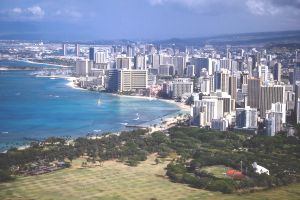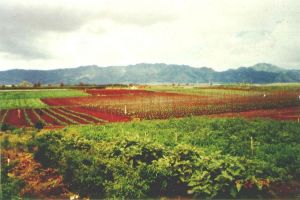Laws & Rules
In 1978, the State of Hawaii’s Constitutional Convention identified the the State’s “obligation to protect, control and regulate the use of Hawaii’s water resources for the benefit of its people.” Under Article XI, Section 7, of the State Constitution, “The legislature shall provide for a water resources agency which, as provided by law, shall set overall water conservation, quality and use policies; define beneficial and reasonable uses; protect ground and surface water resources, watersheds and natural stream environments; establish criteria for water use priorities while assuring appurtenant rights and existing correlative and riparian uses and establish procedures for regulating all uses of Hawaii’s water resources.”
 |
View of Waikiki and Honolulu. Hawaii’s growing population has resulted in greater competition for water resources between municipal, military, agricultural, private, environmental, and traditional water demands. |
Thus, the idea for the State of Hawaii’s Commission on Water Resource Management emerged. However, the Commission was not established until 1987 when the Hawaii State Legislature enacted the State Water Code, Chapter 174C of the Hawaii Revised Statutes. Under the Code, Chapters 13-167 to 13-171 of the Hawaii Administrative Rules specify and clarify definitions, procedures, requirements, etc., required by, but not specified by law. The Commission establishes and operates under these rules through periodic updating and public participation based on the experience of implementing the Water Code. The Hawaii Well Construction and Pump Installation Standards, in accordance with §174C-86, HRS and §13-168-14, HAR, provide additional guidance for the construction, installation, alteration, and abandonment of wells and pumps statewide.
 |
Diversified agriculture on Oahu. Once the site of vast sugarcane fields, the decline of the sugar industry has opened the door to diversified agriculture. Water remains a valuable commodity on the Ewa plains. |
State Water Code
The State Water Code, Chapter 174C, Hawaii Revised Statutes (HRS) was enacted into law by the 1987 Hawaii State Legislature for the purpose of protecting Hawaii’s water resources. It provides for the legal basis and establishment of the Commission on Water Resource Management and its authorities and responsibilities. Click on the link below to view the State Water Code in Acrobat Reader.
State Water Code, Ch. 174C (2022 Amendments)
(Click here to View / Download)
Accordingly, two years from the effective date of the State Water Code, conflicting chapters within the Hawaii Revised Statutes were repealed. These chapters are referenced below.
|
Chapter
|
Subject
|
|---|---|
|
Chapter 176, HRS
|
REPEALED – Water Resources |
|
Chapter 176D, HRS
|
REPEALED – Protection of Instream Uses of Water |
|
Chapter 177, HRS
|
REPEALED – Ground Water Use |
|
Chapter 178, HRS
|
REPEALED – Well, Generally |
Hawaii Administrative Rules
Administrative rules specify and clarify definitions, procedures, requirements, etc., required by, but not specified, in the law (174C). The Commission establishes and operates under these rules through periodic updating and public participation based on the experience of implementing the Water Code.In July 1987, the Hawaii State Legislature passed the State Water Code, Chapter 174C Hawaii Revised Statutes, for the purpose of protecting Hawaii’s water resources. In conjunction, with the adoption of the State Water Code, the Commission also needed to enact new administrative rules within a two-year time period. Listed below are the current and repealed Hawaii Administrative Rules.
|
Chapter
|
Subject (UNOFFICIAL COMPILATIONS)
|
Amended
|
|---|---|---|
| 13-167 | Rules of Practice and Procedure for the Commission on Water Resource Management |
07/30/2018
|
|
13-168
|
Water Use, Wells, and Stream Diversion Works |
07/30/2018
|
| 13-169 | Protection of Instream Uses of Water | 07/30/2018 |
| 13-170 | Hawaii Water Plan | 05/16/1988 |
| 13-171 | Designation and Regulation of Water Management Areas | 05/31/1995 |
|
Chapter
|
Subject
|
Repealed
|
|---|---|---|
|
13-166
|
REPEALED – Control of Ground Water Use in the State of Hawaii |
05/27/1988
|
|
13-167
|
REPEALED – Protection of Instream Uses of Water, Windward Oahu |
05/27/1988
|
Draft Administrative Rules
Administrative Rules are regulations established by the Commission through an extensive public review and hearing process. The procedure for administrative rules is set by Hawaii Revised Statutes Chapter 91. A proposed rule (or amendment) is drafted by the Commission staff, approved by the Commission on Water Resource Management for public meetings/hearings, and reviewed by the Department of the Attorney General (AG). Then the draft is taken out to public meetings and/or hearings, where the public can give formal testimony on the draft rule. The rule is revised, if necessary, and then submitted to the Commission for final approval. Then it is reviewed again by the AG, and after signing by the Governor and filing with the Lieutenant Governor, it has the effect of law.
|
Date
|
Subject
|
|---|---|
| No draft Administrative Rules pending at this time. |
|
Section
|
Section Title
|
|---|---|
| No draft Administrative Rules pending at this time. |
Environmental Review Program
The Environmental Review Program (ERP) facilitates Hawaiʻi’s environmental review process (commonly known as the Hawaii Environmental Policy Act, or HEPA), pursuant to Chapter 343, Hawaii Revised Statutes (HRS). Chapter 343, HRS, authorizes the Environmental Council to establish procedures to exempt specific types of action from the preparation of an environmental assessment because the action will have minimal or no significant effect on the environment.
The Commission, through time and experience, developed the following exemption list identifying particular activities that fall within the exempt classes described in Hawaii Administrative Rules, Chapter §11-200.1, Subchapter 8. This exemption list was prepared in compliance with the 2019 revisions to HAR §11-200.1. This revision separates exemption lists into categories listed in §11-200.1-16(a)(1) and (2). Activities categorized as “Part 1” will fall under §11-200.1-16(a)(1). Activities categorized as “Part 2” will require an exemption notice and fall under §11-200.1-16(a)(2).
